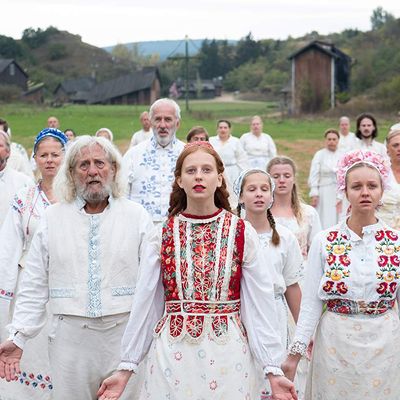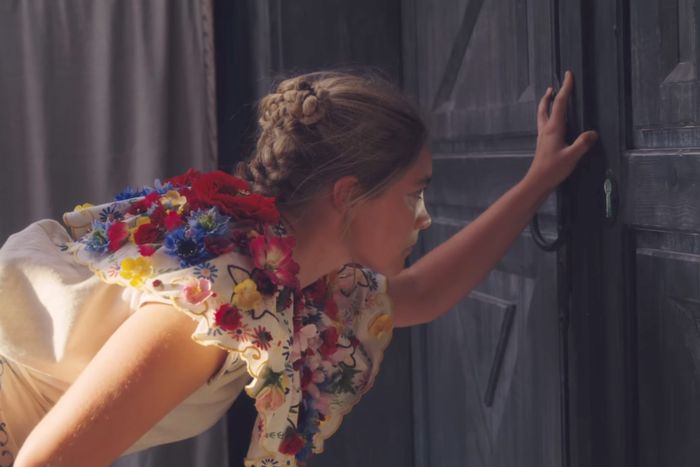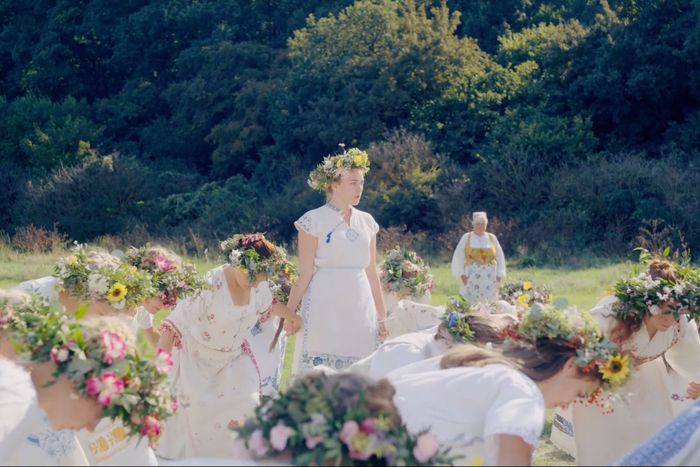
Midsommar, the new movie from writer and director Ari Aster, is the slowest of burns. It’s nearly two and a half hours long, and spends most of that time lulling viewers into a resting state of unease before launching into a finale run that will light your brain on fire. So, what’s going on at the end of Midsommar, and what happens after the flames finally die down? Let’s unpack this beast.
Midsommar follows a group of American grad students accompanying their tender-hearted friend Pelle (Vilhelm Blomgren) on a trip to his remote Swedish village. They’ve come for a special festival that only happens once every 90 years, but the two characters at the center of the story — Dani (Florence Pugh) and her lackluster boyfriend Christian (Jack Reynor) — are preoccupied. Before they ventured abroad, Christian was on the verge of ending things with Dani when a gruesome tragedy struck: Her sister killed their parents and then herself. So instead of initiating a breakup, cowardly Christian invites Dani on vacation.
What they find in Sweden is a bucolic paradise, an almost totally self-sufficient, closed-off community. Everyone living there is kind, empathetic, and welcoming. The outsiders — including a pair of visiting Brits — are accepted. Or, at least, that’s the façade. Things take a sharp turn when the community invites the interlopers to a time-honored suicide ritual, which is explained as a beautiful choice on the part of the oldest Hårgan people, who decide to give up their bodies before they have the chance to rot away. It’s a straightforward explanation, but one that leaves a bad taste in the shocked newcomers’ mouths. Festivities continue with large communal meals and a steady diet of hallucinogens, and tension starts building within the American group. Dani and Christian drift further apart as she tries to compartmentalize her recent trauma while finding herself drawn to the strange practices of the Hårga.
The wandering nightmare continues for about two hours — it’s slow but very effective — before the action picks up, and fast. Dani finally takes part in the euphoric drug-fueled dance ceremony we’ve been waiting for and is crowned May Queen. It’s the most important designation of the festival, and immediately after her victory, she’s carried away to tend to her honorific duties of blessing crops. Meanwhile, Christian is tasked with a different kind of duty. He’s been engaging in a long and creepily flirtatious staring contest with a Hårgan villager, who is now asking him to have sex with her inside a sacred temple. You see, the bloodlines of the Hårga are mapped to prevent incest (except for the village oracle, who is explicitly required to be a product of incest), and they need occasional outside sperm donors, if you will, to bring in fresh genetic material. Dani returns to the village just as Christian is carrying out his mandate under extreme duress. She catches sight of the ritual through the temple’s keyhole: Middle-aged naked women are writhing and singing around her boyfriend mid-coitus. One old woman goes as far as to push on his ass cheeks to intensify the thrusting.
Dani, like any reasonable person, throws up immediately and flees to the sleeping quarters. As she sobs and wails on the floor, purging all the pain and resentment she’s built up inside herself, the women around her form a sort of human shelter, panting and crying in sync with her, putting the weight of her trauma across their backs. In that moment, they give her the connection she has lacked this whole time — the connection Christian never gave her. And he’s not exactly rushing to be with her now. In an attempt to hide his naked, ashamed self from the others post-ritual, he ends up in a barn where the splayed body of one of the Brits — who he previously believed had voluntarily left the Swedish compound — has been put on a horrific display. That’s when Christian, too, is captured. It is obvious now that the festival, which at first seemed so quaint, has been mounting toward death the entire time.
And now we arrive at the grand finale. Christian wakes up to find that he’s been drugged into a state of paralysis. He can only grunt and watch as Dani is told to select the final sacrifice of the Midsommar festival; as May Queen, it is her honor. Enrobed in flowers and surrounded by doting followers, she must choose either one among them (the Hårga) or one among her own (Christian) to send into the purifying flames. In the end, the Hårga are a people capable of rationalizing any behavior as good for the whole. They can absolve themselves of seemingly any beneficial act so long as they share in the pain of whomever is harmed in the process.
Reynor says that filming this Midsommar ending made the duplicitous motivations of the Hårga clear. “It was a difficult sequence to do, and there was a weird subtext in everyone’s performance,” says Reynor. “Every one of the Hårga, on the outside, felt like [the festival] was an exhibition of appreciation and peacefulness, but the subtext that existed underneath all of that was vitriol. It was pretty terrifying to be working with all these people who, in their eyes, you can see their determination to commit murder. All while they’re wearing smiles and dancing and celebrating together.” That duality was one director Aster wanted to emphasize. “It was important to me that they do have two sides,” he told Vulture. “That they have a certain attitude towards each other and to the world around them and nature, and then they have this other attitude towards the visitors.”
It’s easy to guess Dani’s decision before she delivers it. Having swallowed the pain of Christian’s detachment so many times, and having experienced an acceptance among the Hårga she can’t bear to lose, she chooses him as the festival’s final victim. And so he is sewn inside a hollowed-out bear carcass and placed in a ceremonial building along with the other tributes — some dead already but a few still alive. The building will be burned down with everyone inside. As the flames roar, and one of the villagers inside screams out in agony, the onlookers explode into what Reynor calls an “orgy of emotion.” At this point, Aster’s score becomes even more enveloping. The director told Vulture that he and the composer Haxan Cloak were “working towards a certain catharsis and towards this certain feeling of awe, as opposed to a feeling of horror.”
Meanwhile, Dani’s face becomes a time-lapse reflection of her feelings. She stands between the emotional orgy and the flames, looking at once lost, frightened, confused, overwhelmed, disgusted, sorrowful, and regretful for what she’s done. But as the Hårga’s flailing and crying intensifies, and as bear-suited Christian is consumed by fire, Dani’s demeanor shifts. Much like extreme empathy gave way to sociopathy among the villagers, madness gives way to peace for Dani. She is crying, but smiling too, seemingly allowing her pain be buried under the embers and her soul to be sublimated into the collective existence of her new community.
As Aster has noted, Midsommar is in part a breakup film. He was sorting through his own heartbreak at the time he wrote it, and he funneled the pain into a folk horror film (one that he was commissioned to write). Dani, he says, became his surrogate in the story, and the Hårga became an extension of her. “It was important to me that this place in many ways kind of serve as a fulfillment of all of Dani’s needs,” says Aster. “I have a hard time watching the film without seeing Hårga as a sort of manifestation of Dani’s will.”
So is Dani’s surrender to the Hårga a happy ending? “In many ways, Dani is moving from one dysfunctional codependent relationship to another, more functional codependent relationship,” Aster told Vulture. “Even though these people are very much in touch with themselves and with each other and with the world around them, even though they’re more present in their own lives then the visitors are, they’re also a very organized — like, upsettingly organized — town of murderers.”





